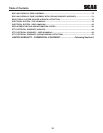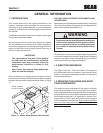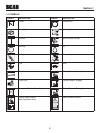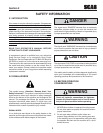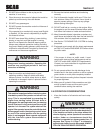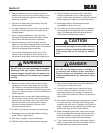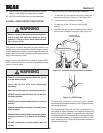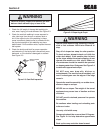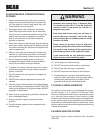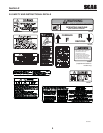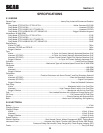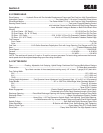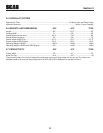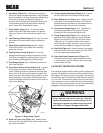
7
R
Section 2
WARNING
Failure to properly inspect and maintain the seat
belt can cause serious injury or loss of life.
Check the full length of the seat belt webbing for 1.
cuts, wear, fraying, dirt and stiffness. See Figure 2-3.
Check the seat belt webbing in areas exposed to 2.
ultra violet rays from the sun or extreme dust or
dirt. If the original color of the webbing in these
areas is extremely faded and/or is packed with dirt,
the physical strength of this webbing may have
deteriorated. If this condition exists, replace the seat
belt system.
Check the buckle and latch for proper operation 3.
and determine if the latch plate is excessively worn,
deformed, or if the buckle is damaged or cracked.
See Figure 2-3.
INSPECT WEBBING
INSPECT BUCKLE
& LATCH
Seat Belt InspectionFigure 2-3.
5
o
10
o
15
o
20
o
Slope Angle GraphFigure 2-4.
WARNING
Reduce speed when turning, operating on slopes,
slick or wet surfaces. Allow extra distance to
stop.
Stay off of slopes too steep for safe operation.
To check a slope, attempt to back up it (with the
cutter deck down). If the machine can not back
up the slope without the wheels slipping, do not
operate the machine on this slope. Under no
circumstances should the machine be operated
on slopes greater than 15 degrees. See Figure 2-4
to determine approximate slope.
DO NOT mow near drop-offs, ditches or
embankments. The machine could suddenly roll
over if a wheel goes over the edge or if the edge
caves in.
Operate the machine smoothly, no sudden turns,
starts or stops on a slope.
NEVER tow on slopes. The weight of the towed
equipment may cause loss of traction and loss
of control.
DO NOT permit untrained personnel to operate
the machine.
Be cautious when loading and unloading onto
trailers or trucks.
Use only a full width ramp.
Ramp angle should be no more than 15 Degrees.
See Figure 2-4 to help determine approximate
slope.
Back up the ramp and drive down forward.



